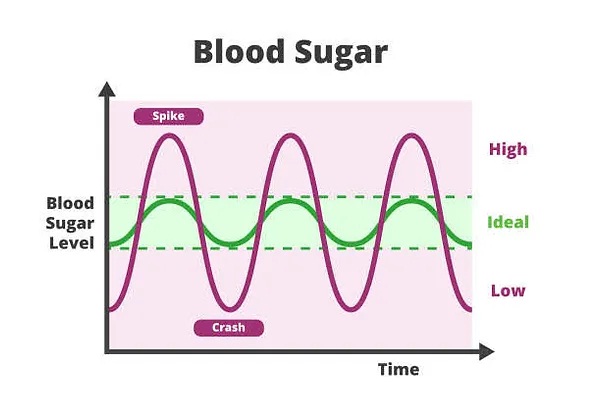“MANAGING GLUCOSE SPIKES : UNDERSTANDING THE DANGERS AND EFFECTIVE MITIGATION STRATEGIES”
Glucose spikes refer to rapid and significant increases in blood glucose (sugar) levels after consuming food, particularly carbohydrates. They occur when the body’s insulin response isn’t sufficient to regulate the amount of glucose entering the bloodstream. Glucose spikes can be problematic for individuals with diabetes or insulin resistance, as they can lead to various health issues over time. Monitoring and managing diet, medication, and physical activity are common ways to help prevent or mitigate glucose spikes.
Harms of Glucose Spikes
Spikes in glucose levels can lead to various health issues, including:
Type 2 Diabetes:
Repeated spikes can contribute to insulin resistance, increasing the risk of developing type 2 diabetes over time.
Cardiovascular Problems:
Elevated glucose levels can damage blood vessels, increasing the risk of heart disease, stroke, and other cardiovascular complications.
Weight Gain:
Rapid fluctuations in glucose can lead to overeating and weight gain, as well as disrupt the body’s ability to regulate appetite.
Energy Fluctuations:
Sharp increases followed by crashes in glucose levels can cause energy fluctuations, leading to fatigue and reduced productivity.
Nerve Damage:
Prolonged high glucose levels can damage nerves, leading to neuropathy and other nerve-related problems.
Kidney Damage:
High glucose levels strain the kidneys, potentially leading to kidney damage and impaired function.
Vision Problems:
Elevated glucose levels can damage blood vessels in the eyes, increasing the risk of diabetic retinopathy and vision loss.
Compromised Immune System:
High glucose levels can weaken the immune system, making it harder for the body to fight infections.
Managing blood glucose through a balanced diet, regular exercise, and medical supervision is crucial for preventing these potential harms.
Control Glucose Spikes After Meals
Managing spikes in glucose after meals is essential for individuals with diabetes or those looking to maintain stable blood sugar levels. Here’s a detailed guide:
Choose the Right Carbohydrates:
Opt for complex carbohydrates like whole grains, legumes, vegetables, and fruits with a lower glycemic index (GI). These foods release glucose into the bloodstream more gradually, preventing rapid spikes.
Portion Control:
Watch your portion sizes. Overeating, even of healthy foods, can lead to elevated glucose levels.
Fiber Intake:
Include high-fiber foods in your meals. Fiber slows down digestion and helps regulate blood sugar levels. Examples include oats, barley, lentils, beans, and vegetables.
Protein-Rich Foods:
Incorporate lean protein sources like poultry, fish, tofu, and legumes. Protein can help stabilize blood sugar by slowing down carbohydrate digestion.
Healthy Fats:
Include sources of healthy fats, like avocados, nuts, seeds, and olive oil. These can help slow down the absorption of carbohydrates and maintain stable glucose levels.
Avoid Sugary Beverages:
Opt for water, herbal tea, or unsweetened beverages instead of sugary drinks, which can cause rapid spikes in glucose.
Limit Added Sugars:
Minimize foods and drinks high in added sugars, such as sweets, desserts, and sugary snacks.
Meal Timing:
Try to eat at regular intervals to avoid long gaps between meals, which can lead to blood sugar imbalances.
Hydration:
Stay hydrated. Dehydration can affect blood sugar levels, so drink enough water throughout the day.
Physical Activity:
Engage in regular physical activity, such as walking or light exercise after meals. This can help improve insulin sensitivity and assist in glucose regulation.
Monitor Carbohydrate Intake:
If you’re tracking carbohydrate intake, you can calculate your carbohydrate-to-insulin ratio to determine how much insulin you need for a given amount of carbohydrates.
Blood Sugar Monitoring:
Monitor your blood sugar levels regularly to understand how different foods affect your body. This will help you make informed choices.
Medications:
If you’re on diabetes medications, take them as prescribed. Consult your healthcare provider if you’re experiencing frequent glucose spikes.
S P E C I A L .
1.ADD GREEN STARTER TO YOUR MEAL.TO PREVENT GLUCOSE SPIKES.
2.WITH REFERENCE TO ABOVE STARTER BROCCOLLI,SPINACH ,TOMATO ,RADISH ,CARROT WHICHEVER YOU CAN EAT RAW OR SEMI COOKED OR COOKED IN ANY WAY YOU CAN USE GREENS .
(VEGETABLES).JUST BEFORE MEAL.
3 THE QUANTITY IS ABOUT 300 GM.
4.USE A SPOONFUL OF OLIVE OIL AND VINEGAR IN YOUR SALAD ,WHICH IS TO BE TAKEN BEFORE MEAL.
5.MOVE 10 TO 20 MINUTE AFTER YOUR MEAL.GET GOOD RESULT TO CONTROL GLUCOSE SPIKE.
FAQ
Q: What are glucose spikes?
A-Glucose spikes, also known as blood sugar spikes, occur when there is a rapid and significant increase in blood glucose levels after consuming food or drinks that contain carbohydrates. This can happen in individuals with or without diabetes.
Q: What effects do glucose spikes have on the human body?
A- Glucose spikes can have various effects on the body, including:
Short-term effects:
After a glucose spike, you might experience feelings of fatigue, mood swings, and increased thirst or urination.
Long-term effects:
Frequent glucose spikes can contribute to insulin resistance, weight gain, and an increased risk of developing type 2 diabetes over time. They can also strain the pancreas, which produces insulin, potentially leading to complications.
{Nutrition Life Circle} 

My Self Hari singh choudhary
S.N.H.S. Dip.(Holistic nutrition), London, S.N.H.S. Dip. (Advanced Nutrition), London, S.N.H.S. Dip. (Holistic Pain Management), London, S.N.H.S. Dip. (Nutrition for Age 50+), London, S.N.H.S. Dip. (Plant-Based Nutrition), London, S.N.H.S. Dip. (Vegetarian & Vegan Nutrition,) London, Certified Diabetes Educator’s (INDO-VIETNAM MEDICAL BOARD, Associate member of The International College of Holistic Medicine, England.
NATURAL DISEASE ERADICATION
[ NUTRITION THERAPY ]
For Business inquiry:-
Email: nutritionlifecircle@gmail.com
WhatsApp Number: +91 9425090558
